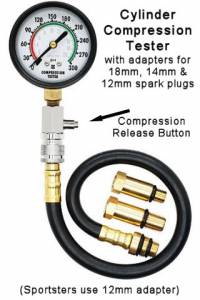Table of Contents
This is an old revision of the document!
EVO: Engine Mechanicals
Cylinder Compression
 It is important to take your Cylinder Compression as soon as you obtain your bike and, at least, on an annual basis thereafter. This is a great reference value to determine if the pistons, rings, cams, lifters, pushrods and valves are all functioning correctly together. Over time, these parts wear and your cylinder compression will reflect when these items should be checked, adjusted or replaced.
It is important to take your Cylinder Compression as soon as you obtain your bike and, at least, on an annual basis thereafter. This is a great reference value to determine if the pistons, rings, cams, lifters, pushrods and valves are all functioning correctly together. Over time, these parts wear and your cylinder compression will reflect when these items should be checked, adjusted or replaced.
New compression readings should be taken whenever any type of headwork, valve reseating, new head gaskets, etc., is performed in order to evaluate the operational functioning and to have a new reference point for the future.
To check your cylinder compression, you need a compression tester/gauge. For less than $25, you can buy a tester with a gauge, hose and adapters at auto supply stores or the auto dept at your local department store.
Using The Compression Tester1)
- Run the engine to get it up to operating temperature (maybe a 10-15 minute ride)
- Let the engine cool down just enough so you can work with it
- Disconnect and remove both spark plugs
- Screw the compression tester into the spark plug hole for the front cylinder
- Lock the throttle open
- Critical - Remove the air cleaner & open the choke or hold the CV Carb slide up
- Crank the engine for several rotations until maximum pressure on gauge
- Record the final reading
- Repeat this procedure for the rear cylinder
Results The difference between the two readings should not be more than 10%. A low reading on either cylinder indicates a possible valve or piston ring issue. To determine which, pour about 1/2 teaspoon of oil into that cylinder through the spark plug hole. Then repeat the compression test. If the reading returns to normal the rings may be defective. If the compression does not increase to within 10% then the valves of that cylinder may require service.
Cylinders
1986-2003 EVO Cylinders
Boring Cylinders
Final cylinder bore sizes after honing. 2)
| Bore Sizes | 883cc | 1100cc | 1200cc |
|---|---|---|---|
| Standard Bore* | 3.0005 in | 3.3505 in | 3.4978 in |
| 0.005 OS Bore | 3.0048 in | 3.3548 in | 3.502 in |
| 0.010 OS Bore | 3.0098 in | 3.3598 in | 3.507 in |
| 0.020 OS Bore | 3.0198 in | 3.3698 in | 3.517 in |
| 0.030 OS Bore | 3.0298 in | 3.3798 in | 3.527 in |
| 0.040 OS Bore | 3.0398 in | 3.3898 in | —- |
* All bore sizes +0.0002 in
- When cylinder requires boring beyond 0.040 in 883cc or 1100cc or beyond 0.30 in 1200 cylinders, the oversize limit has been exceeded and the cylinder must be replaced.
- Boring and honing must be done with gaskets and torque plate in place. Bore the cylinder to 0.003 in under the desired finished size. Hone the cylinder to match the piston clearance using a 280 grit rigid hone followed by a 240 grit ball hone. Hone from the bottom end (crankcase side) of cylinders working for 60 degree cross hatch pattern.
Cylinder Bore Service Limits
| Bore Sizes | 883cc | 1100CC | 1200CC |
|---|---|---|---|
| Standard Bore | 3.0035 in | 3.3535 in | 3.5008 in |
| 0.005 OS Bore | 3.0078 in | 3.3578 in | 3.505 in |
| 0.010 OS Bore | 3.0128 in | 3.3628 in | 3.510 in |
| 0.020 OS Bore | 3.0228 in | 3.3728 in | 3.520 in |
| 0.030 OS Bore | 3.0328 in | 3.3828 in | 3.530 in |
| 0.040 OS Bore | 3.0428 in | 3.3928 in | —- |
Check Your Cylinder Size With a Straw
- Like this:
- Put in 5th gear
- Lift rear wheel
- Remove spark plugs
- Place a long plastic straw in the spark plug hole
- Rotate tire to move cylinder to bottom dead center - lowest straw position
- Check cylinder diagonal dimension from far bottom of cylinder to lip of spark plug hole
- 883=5.5“
- 1200=5.875
The plastic straw is unable to damage the cylinder and unlikely to fall into the cavity…
